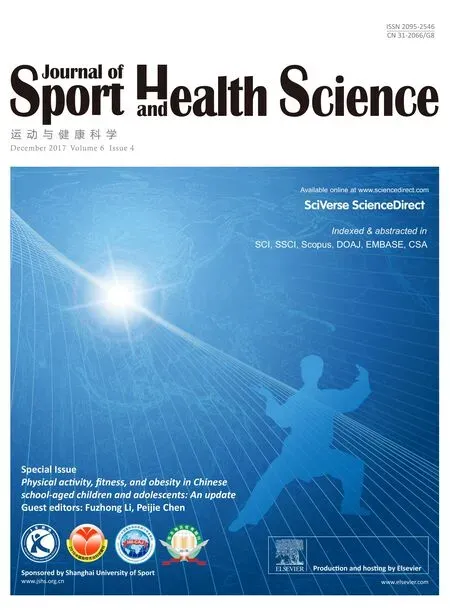Addressing the public health concerns of physical inactivity,low levels of fitness and unhealthy weight among Chinese school-aged children
2017-11-27FuzhongLi,PeijieChen
In China,sports and physical activity(PA)have traditionally been an integral part of school curricula to promote fitnes and enhance healthy grow th among children and adolescents.Three decades of economic reforms,however,have brought major changes in social,economic,and built environments that have resulted in concerns about the general health of the Chinese population due to accumulating epidemiologic evidence of increased levels of physical inactivity,high rates of obesity,and unhealthy diet.With the emergence of a progressively obesogenic environment,lack of safe and accessible exercise facilities,and pressure to excel scholastically,the youth population is not immune to these dramatic threats to health and wellness,with recent evidence pointing to troubling trends in PA and obesity rates among Chinese children and adolescents.1-5
Despite increased awareness of this deteriorating situation,large-scale,population-based epidemiologic studies that allow systematic documentation of patterns and trends in PA and obesity and their correlates in young people are scant.This significant y limits our know ledge about the public health impact of physical inactivity and unhealthy weight,and our capacity to develop evidence-and school-based interventions or fitnes programs to support the national fitnes effort6to promote PA in the people of all ages.To fil these gaps,in 2016 researchers at the Shanghai University of Sport,in collaboration with the Ministry of Education of the People’s Republic of China,analyzed national PA,fitness and weight status data on school-aged children and adolescents.Collectively,these analyses provide the most up-to-date insights and also allow a detailed examination of many unanswered questions about PA and the school and family factors that affect it.
In this special issue of the Journal of Sport and Health Science—entitled Physical activity,fitness and obesity in Chinese school-aged children and adolescents:An update—we present outcomes of these analyses.Five peer-reviewed,original research articles are featured,with specifi topics ranging from reporting on the prevalence of PA,7fitness8and weight status and sedentary behaviors9in school children(aged 7–18 years)to the study of associations of family10and school correlates of PA.11These studies,which are both needed and timely,are of considerable public health significanc and are likely to impact school and community policies and programs that support school,community,and family engagement in PA.These policies and programs can increase opportunities for children’s PA in schools and in their communities,ultimately reducing obesity and improving health.We have also included 3 commentaries that offer some perspectives on the public health significanc and implications of the study finding along with discussions on policy strategies and reform needs aimed at promoting and maximizing school-wide PA.12-14
We hope the outcomes of these empirical studies will not only be used to develop public health and school policies to promote PA but also serve as building blocks for on-going efforts to conduct research in this area.In looking to the future,we realize that a wide array of significan research needs and public health issues must be addressed in order to understand multiple levels of influenc on PA and the prevention of chronic diseases in Chinese youth.From this perspective,we invite Chinese and international scholars to join forces in the figh against global physical inactivity and the obesity epidemic by conducting carefully considered and coordinated PA epidemiology research that focuses on designing and evaluating school-based PA interventions;translating and disseminating effective PA intervention programs;and developing and implementing PA promotion policies and guidelines for young children.
1.Liu Y,Tang Y,Cao ZB,Chen PJ,Zhang JL,Zhu Z,et al.Results from Shanghai’s(China)2016 Report Card on Physical Activity for Children and Youth.J Phys Act Health 2016;13(Suppl.2):S124–8.
2.Ng M,Fleming T,Robinson M,Thomson B,Graetz N,Margono C,et al.Global,regional,and national prevalence of overweight and obesity in children and adults during 1980–2013:a systematic analysis for the Global Burden of Disease Study 2013.The Lancet2014;384:766–81.
3.Duan J,Hu H,Wang G,Arao T.Study on current levels of physical activity and sedentary behavior among middle school students in Beijing,China.PLoS One 2015;10:e0133544.doi:10.1371/journal.pone.0133544
4.Sun H,Ma Y,Han D,Pan C,Xu Y.Prevalence and trends in obesity among China’s children and adolescents,1985–2010.PLoS One 2014;9:e105469.doi:10.1371/journal.pone.0105469
5.Zong XN,Li H.Physical grow th of children and adolescents in China over the past 35 years.Bull World Health Organ 2014;92:555–64.
6.The State Council of the People’s Republic of China.China to Implement National Fitness Program.Available at:http://english.gov.cn/policies/latest_releases/2016/06/23/content_281475378214258.htm;2016[accessed 12.08.2017].
7.Fan X,Cao ZB.Physical activity among Chinese school-aged children:national prevalence estimates from the 2016 Physical Activity and Fitness in China—The Youth Study.J Sport Health Sci2017;6:388–94.
8.Zhu Z,Yang Y,Kong Z,Zhang Y,Zhuang J.Prevalence of physical fitnes in Chinese school-aged children:finding from the 2016 Physical Activity and Fitness in China—The Youth Study.J Sport Health Sci 2017;6:395–403.
9.Cai Y,Zhu X,Wu X.Overweight,obesity,and screen-time viewing among Chinese school-aged children:national prevalence estimates from the2016 Physical Activity and Fitness in China—The Youth Study.J Sport Health Sci2017;6:404–9.
10.Liu Y,Zhang Y,Chen S,Zhang J,Guo Z,Chen P.Associations between parental support for physical activity and moderate-to-vigorous physical activity among Chinese school children:a cross-sectional study.J Sport Health Sci2017;6:410–5.
11.Wang L,Tang Y,Luo J.School and community physical activity characteristics and moderate-to-vigorous physical activity among Chinese school-aged children:a multilevel path model analysis.J Sport Health Sci 2017;6:416–22.
12.Chen P.Physical activity,physical fitness and body mass index in the Chinese child and adolescent populations:an update from the 2016 Physical Activity and Fitness in China—The Youth Study.J Sport Health Sci2017;6:381–3.
13.Ainsworth BE.Step it up:promoting physical activity in school-aged children and adolescents in China.J Sport Health Sci2017;6:386–7.
14.Wang D.Improving school physical education to increase physical activity and promote healthy growth of Chinese school-aged children—Time for action.J Sport Health Sci2017;6:384–5.
杂志排行
Journal of Sport and Health Science的其它文章
- The effects of aerobic exercise training on oxidant-antioxidant balance, neurotrophic factor levels, and blood-brain barrier function in obese and non-obese men
- Footfall patterns of a runner with an Achilles tendon rupture
- Three-dimensional impact kinetics with foot-strike manipulations during running
- Shock attenuation,spatio-temporal and physiological parameter comparisons between land treadmill and water treadmill running
- Tribulus terrestris extracts alleviate muscle damage and promote anaerobic performance of trained male boxers and its mechanisms:Roles of androgen,IGF-1,and IGF binding protein-3
- Heart rate variability to assess ventilatory thresholds in professional basketball players
